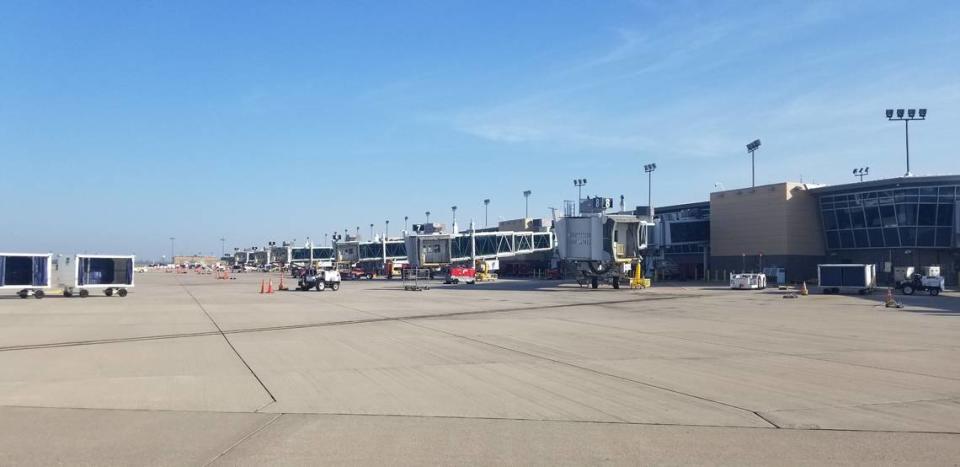A much ballyhooed addition to Wichita is hot, hot, hot — literally and figuratively
If you’re flying in and out of Wichita on scorching triple-digit days this summer, you might be confused about Wichita Dwight D. Eisenhower National Airport’s much-ballyhooed glass jet bridges.
Wait a minute, more than one person has thought, aren’t these supposed to be air conditioned?
“I can give you the short answer: Those glass boarding bridges are doing everything they can do,” said Brad Christopher, assistant director of airports and COO.
“Those darn boarding bridges . . . are just like standing under a magnifying glass under that sun,” he said. “This time of year, we do have some calls, concerns (and) complaints.”
The longer answer, Christopher said, is the interesting backstory on the bridges — the technical term is passenger boarding bridges, but they’re also known as loading bridges, jetways and jet bridges — and the disagreement he and former director of airports Victor White had when selecting them during the new airport’s design phase.
White was all for them. Christopher, not so much.
He was concerned they might be like standing in a greenhouse. He worried what birds might do to the glass in the natural course of their days. Mostly, though, Christopher was uneasy about being one of the first customers for glass bridges nationally and that there weren’t other airports Wichita’s size to learn from about how they performed.
Glass bridges have been popular in Europe and Asia for some time, but Christopher said, “When we bought the boarding bridges, we were the largest U.S. customer of glass boarding bridges.”
The new Wichita airport opened in 2015. Prior to that, only two or three other domestic airports had the glass bridges, and each of those had only two or three at most.
Normally, glass bridges cost more than metal ones, but the 11 that Wichita purchased did not because Utah-based Jetway Systems wanted to promote the bridges through Wichita’s use of them.
“They gave us an incredible price, so we said, ‘Yep, OK, let’s do the glass boarding bridges,’ ” Christopher said.
He said he and White knew the downside was that at certain times, “It might get a skosh warm in there.”
Chilling trivia
Though air travelers may question this on the hottest of days, Christopher said, “We did not cut corners or slouch on chilled air or cooling capacity for those bridges.”
Each bridge has two chillers on top with a combined 20-ton chilling capacity.
“That’s a bunch on top of each one of those,” Christopher said.
There is an additional 30-ton unit on the bottom of the bridge that is designed to hook up to airplanes to cool them as they sit on the tarmac.
“Here’s a bit of trivia for you,” Christopher said. “All of those 11 boarding bridges have more tonnage chilling capacity than the terminal building itself.”
The July electric bill for air conditioning the bridges was $5,000. For the same month, the cost for operating the electric-powered bridges themselves was $4,000.
Part of the problem with cooling the bridges is the doors on either end of each bridge.
To board passengers, there are sliding doors at the end of the bridges that lead to the planes.
“So it introduces all of the hot air,” Christopher said.
The doors that open onto the terminal building create a vacuum, he said, that sucks hot air from the end of the bridges into the terminal.
“It’s just physics. . . . It’s almost like trying to air condition your car with the windows rolled down.”
The bridges aren’t insulated. Nor are they heated in the winter.

The sun can help heat the bridges in the winter just as the tarmac, which Christopher said can reach temperatures of 120 degrees on extreme days, heats the bridges during the summer.
“We knew it would not feel like a bank lobby or your office. . . . The goal was to keep you comfortable.”
So even if it’s a bit warm, he said, hopefully you’re at least “just below a sweat.”
Told you so
Just as representatives of Jetway had hoped, Wichita’s glass boarding bridges have attracted attention.
When the Kansas City airport was preparing to build a new facility, Christopher said its airport director and architects came to visit Wichita’s airport.
After seeing the jet bridges, “They said, ‘We’re getting glass boarding bridges. We love those.’ ”
They’ve been equally popular with passengers, Christopher said.
“We get so many comments.”
For people who are claustrophobic, he said the glass helps the bridges feel a little less confined.
Some of the glass panels on the bridges have fractured in the almost decade they’ve been in use.
“Sometimes glass in a moving vessel like that will just crack, and that glass is quite expensive to replace,” Christopher said.
Still, he said, they’ve been a good choice, and Wichita was a forerunner for something that has become a trend nationally.
That’s quite a bit for him to admit given his insistence that the airport stick with traditional metal passenger bridges while White was adamant that Wichita needed the glass ones.
He can’t quite remember if White said, “Told you so,” but Christopher does remember admitting he was wrong.
“I said, ‘You know what Victor? You were right. People love them.’ ”

